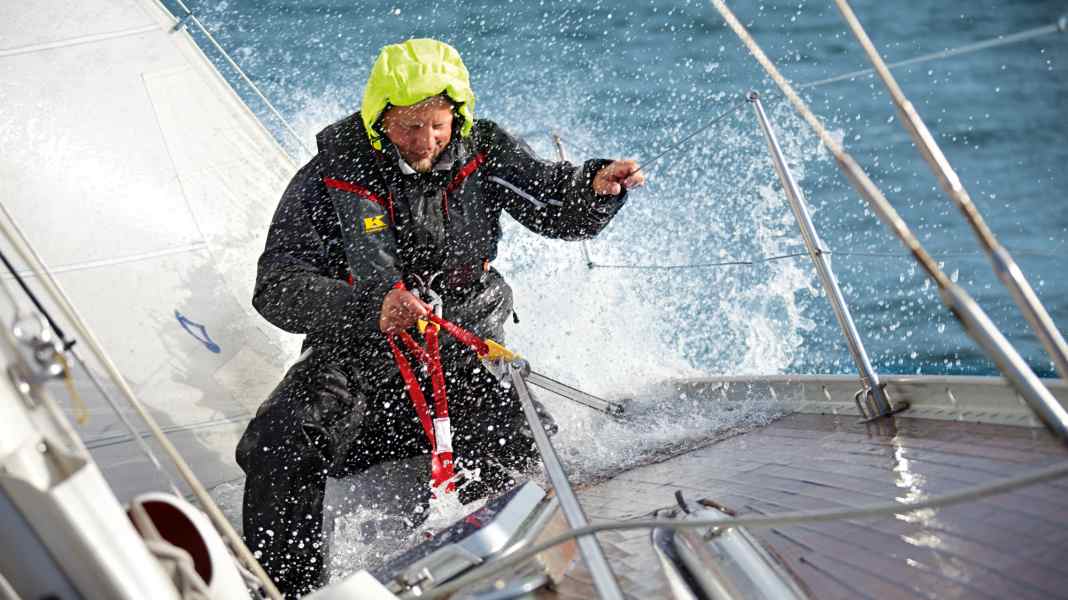
Spray flies horizontally aft, green water shoots across the deck again and again. The bow hits the waves hard, the wind howls, the boat heels. Fun definitely feels different. At wind speeds in excess of 25 or 30 knots, even hardened regatta professionals start to get serious on board. Most leisure sailors prefer to enjoy a day in the harbour in such conditions anyway, and for good reason. The risk of unnecessarily jeopardising the ease and good humour of the crew is too great.
But what happens when surprisingly tough weather sets in? For such cases, we spoke to two of the most experienced training skippers and have compiled the most important manoeuvring tips for strong winds on the following pages.
Further links:
They are not recipe-like flow charts. The events are too complex for such simplifications, and the boats, equipment, crews and conditions are too different. For example, 30 knots under sail in the shelter of a lee shore on a modern performance cruiser can actually be a pleasure. Towards the open sea, however, in short, high, choppy waves, it would be a completely different story. The same pressure suddenly feels like a battle, especially as everyone on board intuitively senses: one or two more wind forces and it's really all about going for it.
So don't expect a one-off guide to strong wind tactics. Instead, you will find practical recommendations that you can adapt to the situation. It is helpful if the skipper and crew are familiar with their boat and know their own strengths and the strengths of the design. If there is a lack of experience, as is often the case on charter trips, it is important to compensate for the deficit with a more defensive approach: if in doubt, simply take the sails away completely instead of making a mistake or wearing yourself out when reefing.
And perhaps most importantly: Always think in terms of alternatives. If all hell breaks loose in a storm, it's good to have a plan B, an alternative harbour, a course that is less demanding on the crew. It's the be-all and end-all of cruise planning, but it's all the more important when the going gets tough.
The experts
Leon Schulz

The yachtmaster instructor sails 46 ocean cruises with his Hallberg-Rassy. He has also made a name for himself as an author, for example with the book "Fahrtensegeln" by Delius Klasing
Constantin Claviez

With more than 250,000 nautical miles and 19 Atlantic crossings under his belt, the Swan 441 owner is one of the most sought-after professional skippers. He also regularly sails long-distance regattas with guests.
Reefing
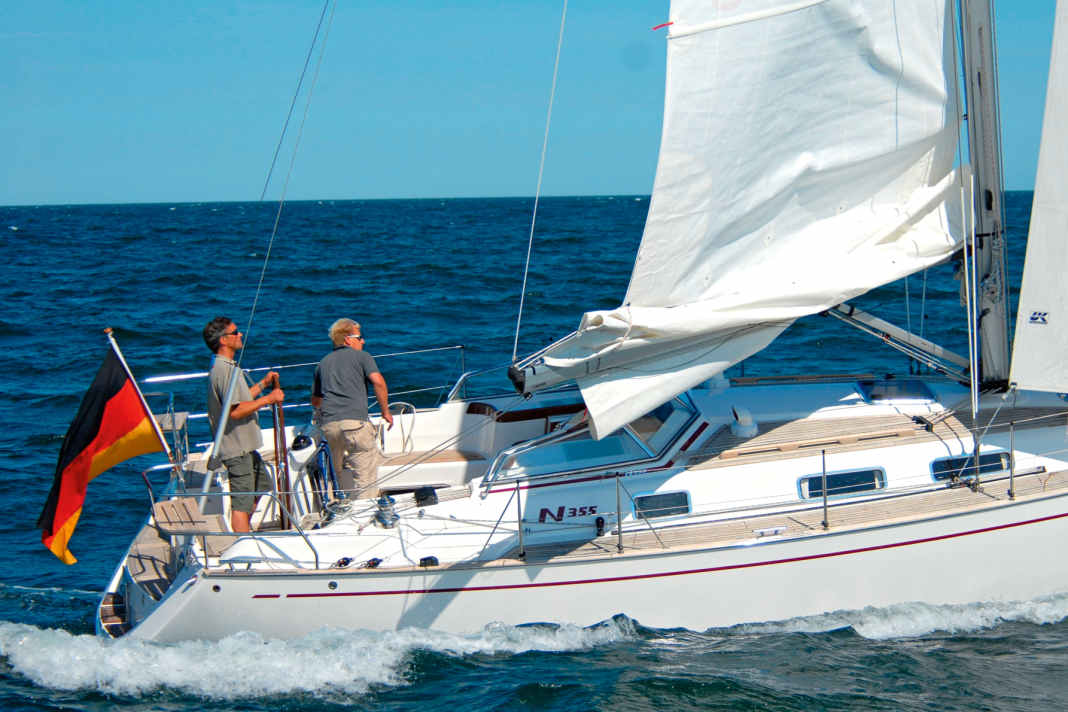




If the anemometer goes up, the sail area has to go down. With practice and a few tricks, this can be done in no time - and it not only relieves the rig enormously
The most important thing when sailing is to be able to reef quickly," says Leon Schulz. That's how you take the wind out of the way and maintain control. According to the Yachtmaster instructor, you need to practise the manoeuvre regularly to make sure it works: preferably not just in a light breeze, but gradually increasing the speed, at 15, 20, 25 knots.
If you are planning long passages, you should have a third row of reefs installed if the main is reefed conventionally. This is not necessary with furling mainsails, as the cloth can be removed as far as required.
"As skipper, I have to make sure that the crew is able to reduce the sails on any course"
When to reef? That depends on several factors: Sea state, course, gust potential and, last but not least, the rigidity of the boat. For cruising catamarans, there are tables laid down by the designer. For monohull yachts, feeling is also sufficient. An old rule says: "If you are thinking about reducing the size of the sails, do it!" If in doubt, leave a few tenths of a knot and a few degrees of height on the wind, but it is a practical approach for cruising sailors. This is because the boat pushes less, no longer has a tendency to sunshade and the sheet loads are reduced. On upwind and half-wind courses, performance can even increase after reefing and drift can decrease. The following points help when manoeuvring and sailing with a reduced surface area:
- Markings on the main halyard and reefing lines speed up the process, as the sail does not have to be lowered by sight or feel.
- When reefing, it is better to use a tight luff and foot than a loose one. Otherwise there will be too much profile and resistance. Leave the reefing lines and halyards on the winches, if possible, and secure them with one more turn or half a beat to prevent them from slipping out of the selftailer unintentionally. If the winches are used for other purposes, secure the lines behind the stoppers with Slipstek to prevent them from slipping through. This also applies to the winding line of the genoa furler.
- If the furling genoa does not have compensation strips in the luff, a belly will form when reefing, which produces more lay than propulsion. In windy conditions, it may be better to furl the sheet completely. If the genoa is reefed, the sheet car must also be moved forwards, but not too far. The leech should open at the top.
- If reefing is no longer sufficient, modern yachts usually sail well under genoa or reefed main. What suits the boat and course best should be tried out beforehand in moderate conditions.
Turning
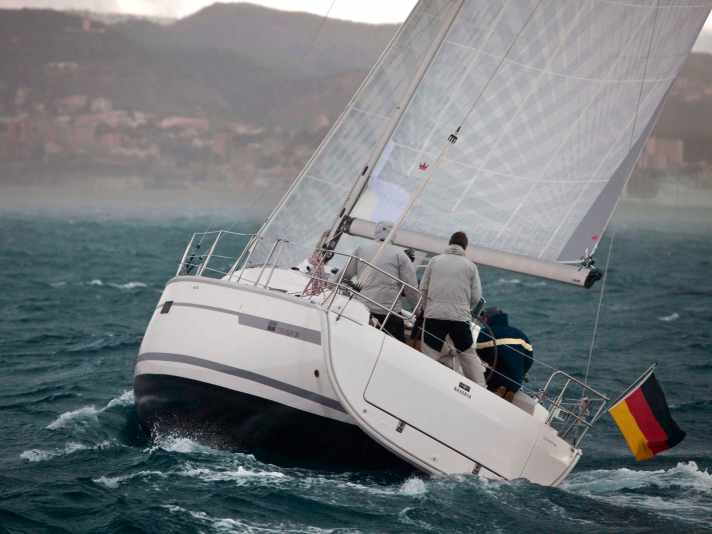
The mother of all manoeuvres should always be done right, even in demanding conditions. How to manoeuvre cleanly with the bow through strong winds and why the engine can also help with waves
Modern yachts have virtually trivialised the cross. With only a slightly overlapping genoa, the sheet paths remain short; if you have a self-tacking jib, you only need to lay the rudder. And yet this basic manoeuvre, with which every sailing licence training course begins, can be a challenge in strong winds and waves.
If you approach the tack too deeply or steer the change of direction too hesitantly, you can literally "starve to death". The boat then becomes a plaything of nature: it drifts back and onto the old bow, accompanied by the thunderous flapping of the sails. If you run too much height, you can also get stuck in the wind because you lack the speed and momentum to get through the sea.
"It is particularly important on upwind courses to keep as much stress away from the crew as possible"
In wavy conditions and in a stormy, possibly gusty breeze, it is not easy to guide a yacht cleanly along the wind edge. But this is the prerequisite for a successful tack. During the manoeuvre, the crew member who is best able to cope with the boat and conditions should therefore steer.
If there are enough able-bodied sailors on board who are not too affected by seasickness, you only need two others besides the helmsman for a strong-wind tack - one to release the genoa sheet, one to haul tight, plus possibly a "jumper" on standby in case of unforeseen problems such as a jammed jib on the pulpit. The manoeuvre can also be done two-handed.
"Especially on upwind courses, it's important as a skipper to keep as much stress as possible away from the crew," says Constantin Claviez. In order to minimise the flapping of the headsail during the tack, he reduces its surface area on his Swan 441 a good deal further before going overhead. This shortens the sheet travel and saves material and nerves. However, it requires a sufficiently dimensioned and smooth-running furling system, which is by no means to be found on all standard boats. Furlers running below deck in particular often only allow the genoa to be reefed reasonably swiftly if it is furled on the beam.
The built-in diesel offers another manoeuvring aid, which may sound a little unorthodox. "With its extra thrust, you can safely reach the new bow even when fully reefed, regardless of the height and frequency of the swell," says Leon Schulz. "If you as a sailor are sure that nothing will break when operating the engine in strong winds, it's a good aid," says Schulz. The only prerequisite for using it is that the engine is in perfect condition and the tank is free of deposits. Otherwise you run the risk of the machine breaking down due to impurities in the diesel when you really need it.
Checklist for the manoeuvre
- What applies in general becomes even more important in tough conditions: don't rush! Before initiating the tack, clarify whether there is enough free sea space on the new bow.
- Clear the loose ends of both genoa sheets free of sinkers; place them on the dents, not on the bottom of the plight, where they cannot escape unhindered if accidentally stepped on or, in the worst case, lead to injuries.
- Check that the genoa sheet car is correctly adjusted on the new bow, otherwise correct it now. Take up slack from the windward sheet; do not lay it more than twice around the winch that is active after the tack, otherwise there is a risk of overrunning when pulling off.
- Ensure that the mainsheet traveller is equally far away from the centre position on both bows when the sail goes over. Before setting the rudder, check that both ends of the traveller are securely fastened.
- Inform the watch below deck well in advance of the course change; if loose equipment is lying to leeward, stow or stow away before tacking
- Initiate the manoeuvre with enough speed, depending on the wave and boat, from an angle of 40 to 50 degrees to the true wind. Do not go over stay too quickly; then the trimmer can tighten the genoa sheet almost without load.
Jibs
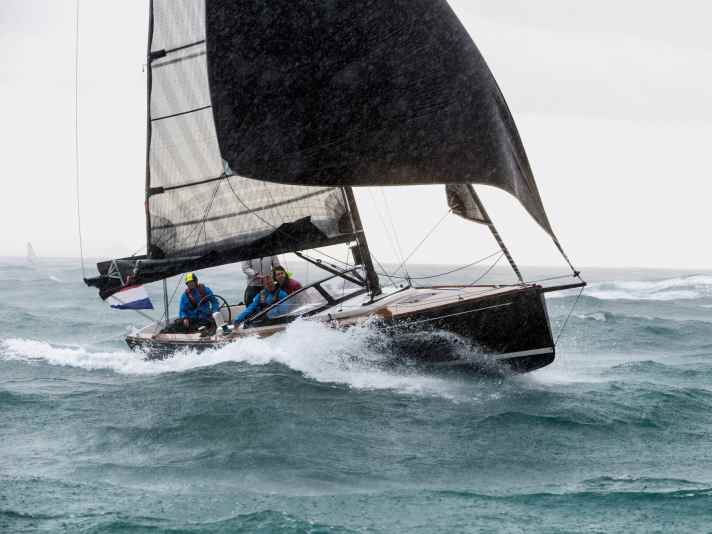
The apparent wind is less than on the cross, but it can still make a mighty bang. So what to do?
No matter how cleanly you go through the wind with the stern, how perfect the timing is, and even if the traveller and mainsheet have been tightened in good time beforehand: As soon as the boom changes sides, the wind is going to start crashing and rumbling. Even fast furling doesn't help.
This is one reason why quite a few sailors have a lot of respect for a strong wind jibe. And indeed, an uncontrolled manoeuvre puts so much strain on the rig and deck hardware that it can break - which is why many sailors prefer to take the longer route when in doubt and make a Q-tack when hacking.
"As long as you sail appropriately reefed, gybing should not be a problem on solidly built cruising boats"
While respect is appropriate, Constantin Claviez believes that the fear of jibing is unfounded. On his Swan, he practises changing direction with crews even in winds above 6 Beaufort: "If you approach the manoeuvre correctly, I don't see any problem." However, he admits that this cannot be easily transferred to every boat.
The challenge is fundamentally different from a tack. This is because there is no danger of starving to death halfway through, as the wind and waves are constantly pushing from astern. However, the manoeuvres are similar in one respect: a cleanly sailed starting course plays a decisive role in both. Only if the helmsman is able to steer the yacht at a controlled angle of between 140 and 160 degrees to the true wind before gybing can the crew make the necessary preparations in peace.
There are two tactical variants. In the first case, you make speed your friend, because the apparent wind is weakened by travelling in the boat and thus also the force with which the main goes over. To utilise this effect, you steer actively and try to bring the boat up to speed down the wave at a true wind angle of around 130 degrees. While still in the surf, the crew tighten the main and traveller and then go over stay at maximum speed. On ships that are planing, you can save yourself the hassle of taking tight even at 6 to 7 Beaufort if the helmsman knows what he is doing, because the wind is effectively only blowing over the deck at force 4 to 5.
The more defensive variant works best in long, high swells. Leon Schulz explains: "I then try to gybe in the wave trough with as little speed as possible." In this case, he reefs the main on his HR 46 to the maximum or furls it away completely; only a cutter jib or reefed genoa provide propulsion. The most important thing in a strong wind jibe is to keep calm and "carry out the manoeuvre step by step", emphasises Schulz.
Checklist for the manoeuvre
- If you are sailing with a small or inexperienced crew, you can simplify the procedure by either furling the main completely before jibing or furling the genoa.
- If the main remains stationary, it is the main focus of attention during the manoeuvre. Who does what and when must be discussed in advance. Check that the crew has understood all the instructions and announce the individual manoeuvre steps clearly and audibly.
- If the genoa is being sailed: clear the sheets as when tacking and lay them ready on the dikes.
- Just before jibing, first take the traveller in the middle, then hoist the main as close as possible. Keep the sheet clear for furling.
- After jibing, give rudder support so as not to tack too far. Furl the main and traveller quickly but in a controlled manner.
Q-turnaround
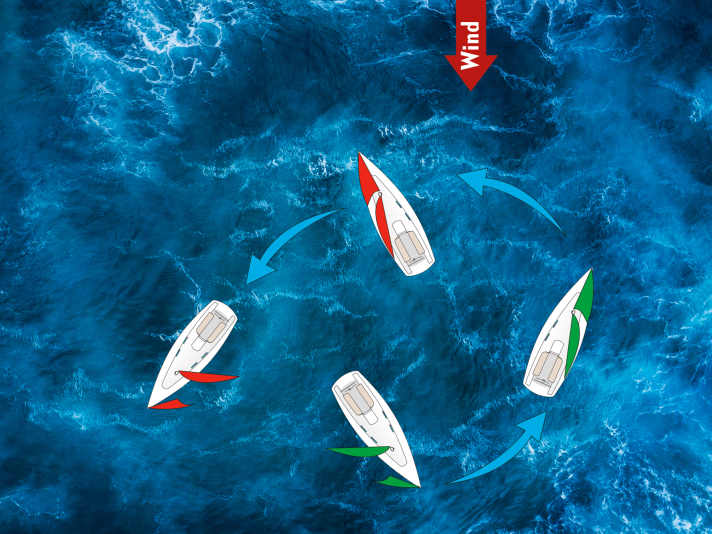
Makes more work than a jibe, but reduces the rig loads
Instead of going through the wind once with the stern, many sailors prefer to make a Q-tack in rough conditions with strong winds. On delicately built boats that are only sailed single- or double-handed, it can even become a standard manoeuvre when sailing on the beam.
Its main purpose is to prevent the main boom from rolling over during a gybe. However, it increases the distance and effort because the yacht has to go upwind for a short time. This means more apparent wind, more sail flapping and more heeling.
Very agile boats that start the manoeuvre with a lot of speed can sometimes get through the wind with the bow without re-trimming the sails. On slower cruising boats, on the other hand, the sheets first have to be taken tighter and then reefed after the tack, which requires strength and good coordination. The advantage: Excessive flapping of the sails is avoided, which is easy on material and nerves.
Leon Schulz warns us to weigh up the options carefully: "You should really think about whether you want to do a Q-turn. The problem is, as with the classic tack, that you have to sail upwind for a short time."
This is not easy in stormy conditions - especially if there is still too much sheet from the space sheet course, which is often the case. "Less experienced crews underestimate how much the apparent wind increases during manoeuvres," warns Schulz.
Checklist for the manoeuvre
- Check whether the boat is sufficiently reefed for the Q-tack. If in doubt, reduce the sail area beforehand.
- Instruct crew well, prepare manoeuvres conscientiously: Are the genoa sheets, main and traveller ready to be hauled and fished?
- When the helmsman starts to luff from the space sheet course, the boat reacts with a clear attitude. This makes it difficult for the genoa trimmer downwind. If possible, lay the genoa sheet on the windward winch until the tack is initiated (cross-sheeting).
- Steering the manoeuvre requires precise timing. If you sail it slowly, you need good upwind trim, especially in the genoa.
- After the tack, furl the main and genoa strongly, then drop significantly.
Set bull stand
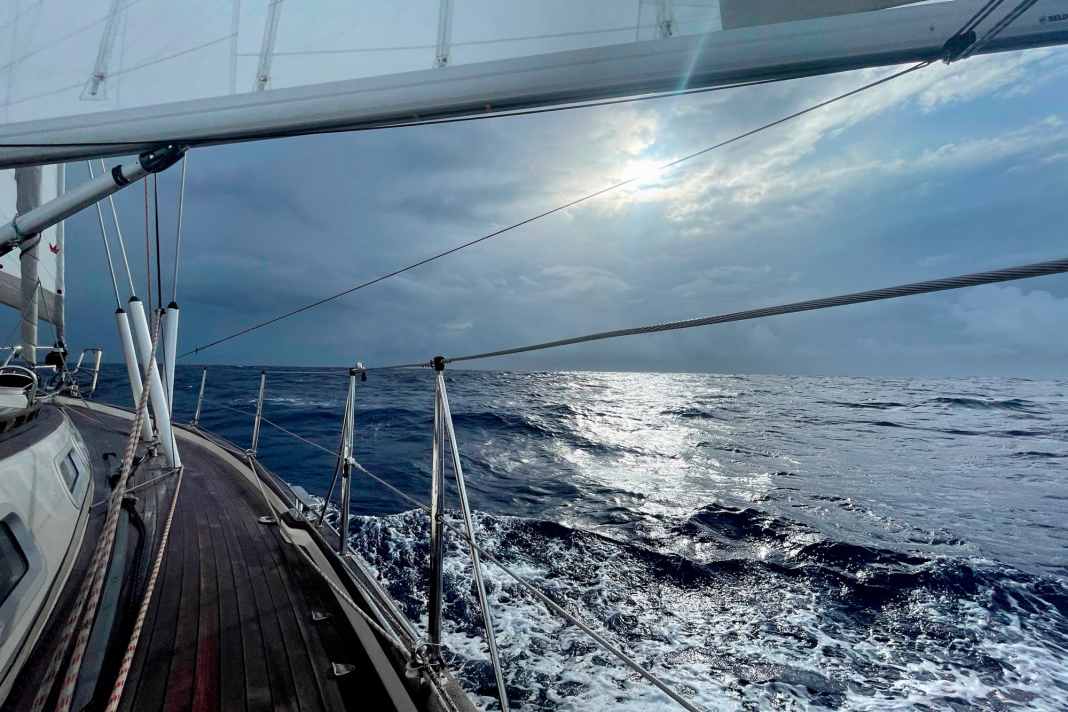




A lot of wind usually also means a lot of swell. If you have to keep low, you should use a line to prevent the boom from rolling over unintentionally
It has already been mentioned several times before: When it's choppy at sea, things on board should be as organised and surprise-free as possible. To ensure this, a manoeuvre that many people have probably never done before is useful on a space sheet course. Strictly speaking, it is more of a tool than a sequence of steps - or rather: a mixture. In any case, it is worth understanding and being able to use both. Because it provides peace of mind and course reserves.
The bullstander secures the boom against unintentional overtopping. This can happen faster than you think in strong winds. Sometimes a breaker running at an angle is enough to turn the stern and suddenly change the yacht's course to the wind. It can be an autopilot that reacts too slowly and steers too low, or a fellow sailor who is no longer fully focussed at the end of his watch.
"Why not put in a bullstander in case the wind picks up and the main comes back?"
On low courses, the bull ensures that the course deviation does not turn into a patent gybe and the boom strikes the wrong side. Hence the English term preventer: Preventer. It acts as a kind of "counterpart" to the mainsheet and fixes the boom together with the mainsheet to leeward and to windward.
"I'm a fan of the bullstander, and I also like to use it on a half-wind course when I notice that the sea is picking up," says Constantin Claviez. Just like the reefing system, the bullstander has to be quick to set even in difficult conditions - and it also has to be easy to fiddle.
"The cockpit is the safest place on deck, so of course it should be set from here," emphasises Leon Schulz. He has rigged a permanently operational system on his ship that makes it unnecessary to go to the foredeck to attach the safety line. Dyneema lines with a high breaking load run along both sides of the deck of his HR 46, which can be stopped on the coaming and can be redirected to one of the sheet winches via thimbles in the cockpit. These are used to pass through and release the bull. The actual safety line from the boom cam then only needs to be connected to the operating lines amidships, which can be done in seconds.
Jibing requires a little more time. To do it safely, you first have to luff up to around 150 degrees to the wind. "Then I release the bullstander, guide the boom into the centre with the help of the mainsheet, only then - and only then! - and slowly go through the wind with the stern in a controlled manner," explains Schulz. On the new bow, the main is immediately furled, set to the new target course and the bullstander is then set on the new side.
Enclosures
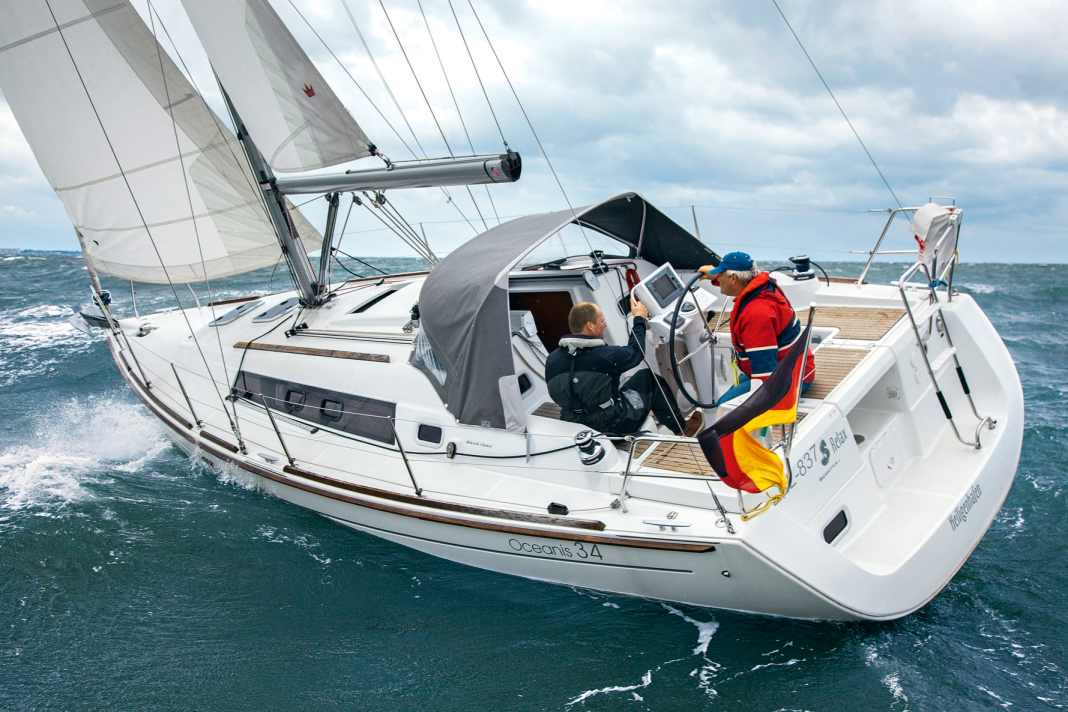




If running downwind is not an option, you can bring calm into the boat with the headsail standing back. This is a blessing for clearing or gathering strength
It is taught in sailing school training, both in theory and in practice. In reality, however, it is probably the manoeuvre most sailors forget most quickly and are therefore least familiar with. Yet it can work wonders.
Being alongside takes all the stress out of a trip in strong winds and gives the crew the opportunity to take a deep breath, cook, eat, go to the toilet or, if necessary, repair something while the boat is minimised and moving smoothly. In a way, it is the pause button at sea.
"It's like magic: when you turn round, you see waves everywhere - and lie almost still in the middle"
"When turning, two opposing forces are at work: the windward-facing rudder generates an impulse to go into the wind, while the back-standing foresail works against it," explains Leon Schulz. Because the two forces cancel each other out, the yacht remains almost stationary. She drifts only slowly to leeward, heels less than on an upwind course and also dampens the swell due to the wake created by the drift to windward.
Contrary to widespread scepticism, every boat is able to do this - from the lightning-fast 18-foot sports cat, where the manoeuvre is known as the "waiting position", to the 140-foot superyacht. At most, there are differences in drift speed. It should be between 0.5 and two knots. If you drift faster, you may have to reduce the sail area further and correct the rudder angle or position in relation to the wind. "Most sailors who think they are leaning over don't do this at all because the boat continues to sail despite the genoa being back," Leon Schulz has observed.
He does not perform the manoeuvre in the classic way, i.e. via a tack, where the genoa sheet remains on the old bow, but rather coming from a space wind course. In doing so, he luffs slowly and furls the genoa more and more. The only important thing is not to tack. "At some point, you have practically no rudder effect, the boat stays slightly higher than abeam, and then everything is fine."
The professional skipper utilises a feature of today's rig concepts. Because the lateral pressure point of the mainsail shifts forwards when reefing, the windward yaw is greatly reduced. "With modern yachts, you often don't need a headsail at all or only a small amount of sailcloth if the main is reefed far enough," says Schulz. You can only find out how your own boat reacts at sea. That's why the following applies to the "forgotten" manoeuvre: "Practice, practice, practice!"

